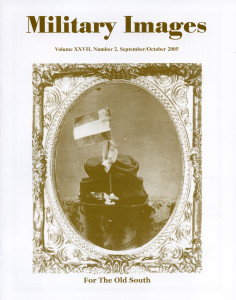The complete issue
Vol. XXVII, No. 2
(40 pages)
Print edition: Visit our store to check availability
Digital edition: Visit JSTOR.org to purchase
Subscribe to MI
Explore the MI Archives: Browse | Advanced search | Tutorial
Inside
Cover image
A unique ninth-plate ambrotype from the David W. Vaughan collection is a Confederate kepi embellished with a small First National pattern flag, ribbon and dogwood flower. The image was likely to have been made in April 1861.
Table of Contents (p. 1)
Editor’s Desk (p. 2)
The editor provides a moving tribute to Brian Pohanka, “A man of boundless energy and courage who dedicated his all-to-shirt life to the preservation of Civil War battlefields and in the discipline of historical scholarship. Indeed, Brian was one of the finest military historians of our time, a man whose body of work included the authorship of many books, countless magazine article and extensive film work. But his influence on the historical community was even greater than the sum of his work, for he was a true inspiration and mentor to countless men and women, whose passion, like his, was history.” The editor also singles out a story in the current issue about an image of the 17th Michigan Infantry. He points out that Military Images does not agree with the author Charles Joyce’s Aug. 3, 1865, dating of the image, but agreed to publish it on the basis of “its historical merits alone.”
Passing in Review (pp. 3-4)
Two books are mentioned: Generals In Bronze: Interviewing the Commanders of the Civil War (Belle Grove Publishing Company) by William B. Styple and Collecting the Confederacy: Artifacts and Antiques from the War Between the States (Savas Beatie) by Shannon Pritchard.
Last Muster for the “Stonewall Regiment;” The Seventeenth Michigan Infantry Returns To The Wolverine State, Summer 1865 by Charles T. Joyce (pp. 5-14)
The author introduces a newly discovered image of the Michiganders in camp as “singularly deceptive. To even the expert eye, it reveals a war-hardened fragment of a Union infantry regiment drawn up in a weedy field by company in ‘column of divisions.’” What follows is a detailed analysis of the regiment and its key personnel that support the theory that the image was produced on Aug. 3, 1865, on the shores of Grass Lake, Mich. Supporting images include a view of the officers of the 17th in camp in 1865 from the State Archives of Michigan and portraits of Col. William H. Withington, Lt. Col. Frederick W. Swift, Maj. Thomas Mathews, Capt. Christian Rath, Capt. Joseph A. Sudborough, Capt. George Goodsell, Lt. and Adjutant Samuel Sizer, Lt. John S. Maltman, Lt. William Leanhouts, QM. Sgt. John M. Lawrence, Corp. Frank Wright and photographer Corydon Randall.
A Tribute to Brian Pohanka (pp. 15-21)
Brian Caldwell Pohanka (1955-2005) is remembered by numerous colleagues and friends associated with him over the course of his eventful life.
The Custer Cyclorama, Revisited by Charles G. Markantes (pp. 22-31)
Subtitled “The subject of a 1983 article in Military Images, the story of the long-lost Custer Cyclorama is explored again,” the author begins by noting that cyclorama paintings were 19th century versions of virtual reality. He continues on to share the history of the Custer Cyclorama, including surviving images of the painting with original 1983 captions by the late Brian Pohanka.
Uniforms & History by Michael J. McAfee (pp. 32-33)
In “The Third Regiment, Michigan Volunteer Infantry, 1864-1865,” McAfee notes that personal accounts by veterans of the Civil War can be extremely valuable to the student of history, but Four Years Campaigning in the Army of the Potomac by color sergeant D.G. Crotty of the 3rd is unfortunately not a useful reference. McAfee details why the volume raises more questions than it answers, and illustrates his text with a tintype of the color guard of the 3rd and a carte de visite of Anna Etheridge, a nurse who found a home with the boys of the regiment.
The Confederate Soldier (p. 34)
A sixth-plate tintype from the David W. Vaughan collection pictures Pvt. Charles Holtzclaw, who served in Company H of the 6th Virginia Cavalry.
Henley Fugate 63rd Tennessee Infantry C.S.A. by John Sickles (p. 35)
Fugate suffered the loss of an arm at Chickamauga after he was struck by a Union cannon shot. A carte de visite of Fugate and his second wife, likely taken in the 1870s or 1880s, accompanies the narrative.
A Palmetto Artillerist and the Columbia Flying Artillery by John Mills Bigham (pp. 36-37)
John W. Self served as second lieutenant of Waties’ Battery B, Palmetto Battalion of Light Artillery, which was first known as the Columbia Artillery and Columbia Flying Artillery. Details of his military service and a brief history of this artillery organization are included.
Stragglers (p. 38)
Three images include a Union soldier with a Sharps rifle, a young Yank with a Bowie knife and a Colt pocket revolver and an unidentified Confederate soldier wearing color shoulder straps.
Sutler’s Row (p. 39)
The Last Shot (p. 40)
A carte de visite from the Chris Nelson collection pictures two Kentucky National Guardsmen portraying Confederates.



































